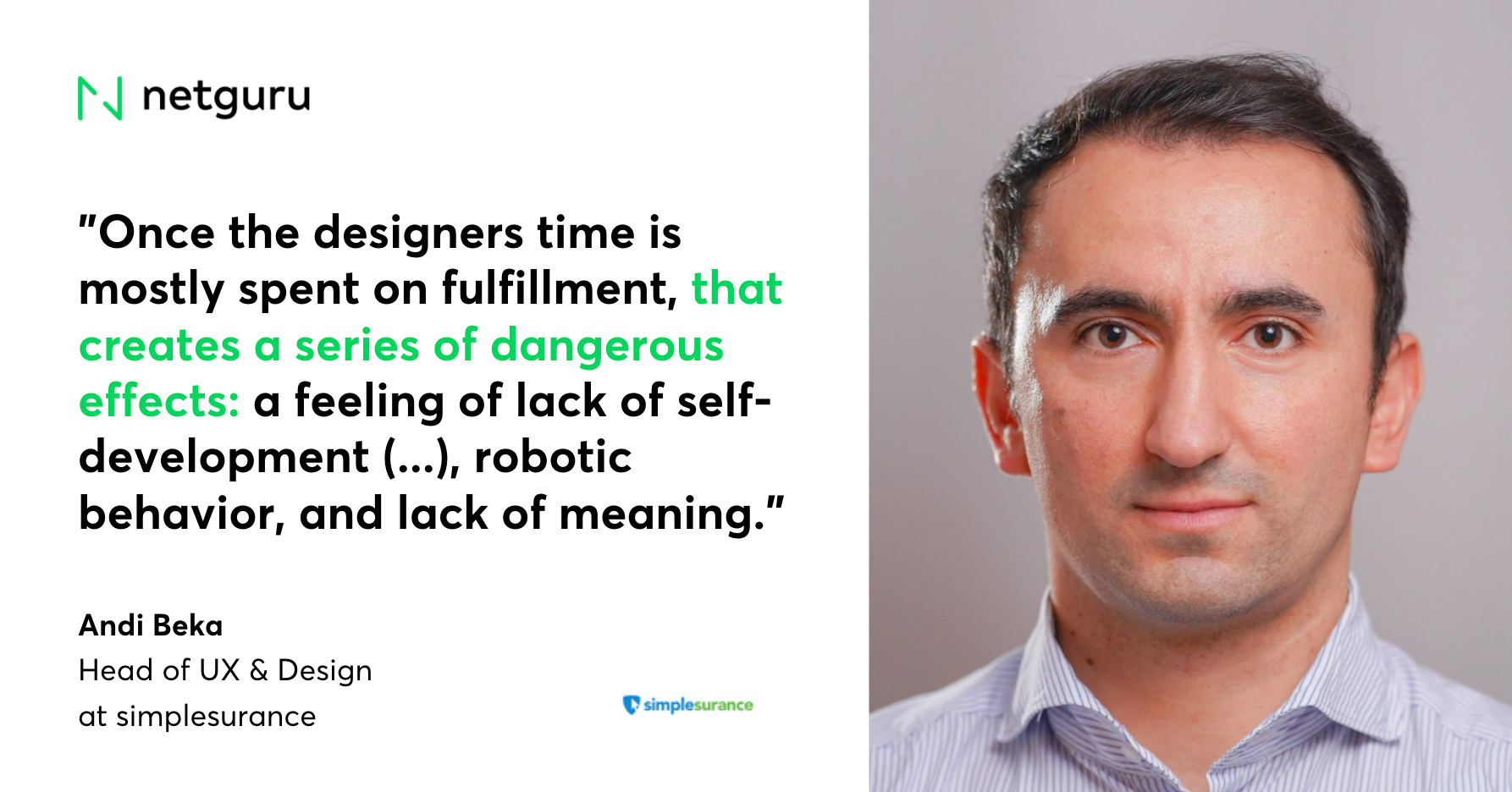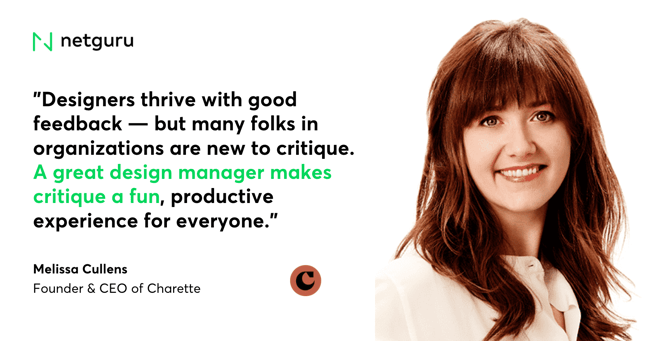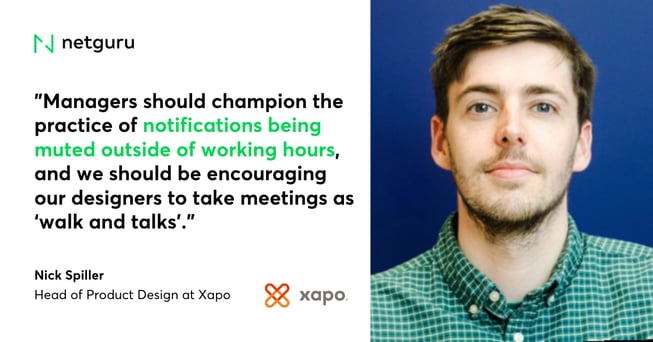8 Tips on How Design Managers Can Prevent Their Teams from Burning Out

These common pitfalls may include: not addressing the feeling of isolation, neglecting self-development of each team member, not motivating designers, lack of vision, no feedback or recognition or, what’s even worse, poorly communicated feedback... The list could go on and on.
The problem of team burnout is real, so we decided to reach out to design leaders and ask for their opinions about the reasons for team burnout. We also collected advice on how to prevent workplace burnout.
8 tips on how to keep designers happy and not let them burn out
Andi Beka
Head of UX & Design at simplesurance

The time and energy of the design team is spread across vital activities such as education, fulfillment of requests, analysis of previous activities, documentation of current activities, and maintenance of design systems and design assets.
Once the designers time is mostly spent on fulfillment, that creates a series of dangerous effects: a feeling of lack of self-development, because much less time is spent on education, robotic behavior, and lack of meaning, because past events have not been fully analysed and processed to generate learning and growth; a sense of chaos, because of lack of documentation and lack of maintenance.
This will increase the mental load over time and potentially lead to burnout symptoms. The Design Manager should keep a good balance between fulfillment of individuals, on-demand requests, roadmap projects, and internal initiatives to continuously analyze, identify patterns, and generalize problems, in order to come up with smarter and more efficient products, maximize learning, and reduce the energy and time spent on fulfillment.
Melissa Cullens
Founder & CEO of Charette
Hosting unstructured critiques is one of the ways I’ve seen teams get burned out. Designers thrive with good feedback — but many folks in organizations are new to critique.
A great design manager makes critique a fun, productive experience for everyone — instead of stakeholders making prescriptive recommendations about details, a good manager elevates the conversation to distill and unpack concerns as business goals so that the designers walk away with a clear understanding of what to work on, but with enough space to find a creative solution.
Toto Castiglione
Deputy Design Manager at Netguru

- Assigning tasks blindly, without context and explanation. In such a situation, your teammates might perceive these tasks as a chore they need to do, as they do not understand how they contribute to the team goals. Always prepare a digestible intro, list a series of “WHYs” to show correlations between tasks, and emphasize how your teammates’ work contributes to the team’s overall strategy.
- Too much micromanagement. What’s the right number of people to control? From my experience – very low. It’s obviously good to have conversations from time to time to align and share ideas, but never ask for progress more than once a day and check the work process in detail on really rare occasions. Focus on the outcome, give people space to make mistakes, then explain why something is not correct and how they can improve it.
- Little or no communication. Lack of dialogue, especially in a remote environment, evokes detachment from colleagues. Be sure you encourage teammates to meet/see each other often, possibly once a week. Discuss not only work-related issues, but also ask appropriate questions about their private lives and show your interest in your teammates’ lives.
- Ignoring the fact that something that seems like a small problem to you can be a really important issue for others. Try to empathise with your teammates and discuss every little frustration. Not doing so could result in burnout in the long run.
Leonardo De La Rocha
Design Director at Intuit
As we continue to work in trying times, good managers are doing their best to create safe spaces for their teams to share how they're coping and ask for help. As well intentioned as this might seem, many of the people we care for at work are overwhelmed by sharing their feelings. In fact, many teammates I've heard from have shared that they see work hours as an escape from real world drama that can be quite exhausting.
The guidance I've given leaders is to be thoughtful around asking people how they feel. Give people the option to share, don't demand or force it. One of the ways I've collected signals around how people are doing is shifting my weekly team check-ins to a more lighthearted vibe.
Every Monday, I reach out to my direct and extended team via Slack with a weekend update thread, but ask for responses to be provided in Emoji form. This allows folks to tap into their creative soul and reflect on the usually fun or productive things they've experienced outside of work and start their week with that energy.
Ken Hubbell
SVP, Sr. Manager, Instructional Design Strategy & Innovation at Wells Fargo Bank NA

Many design managers are keenly focused on leading their teams to create great products. If not careful, however, the desire to continuously get things done can often lead to team burnout. I have found several ways to avoid this problem. With many teams working remotely, don't ignore time zone differences.
This can leave employees tired, hungry, and frustrated with you and their peers. Minimize your Zoom meetings and let your teams focus on designing. Lastly, hit the pause button between projects and make time to reflect and re-energize. These simple ideas will help keep their fires lit and not burned out.
Nina Eklund
Creative Director/Design Consultant at Nina Eklund Design

I have been lucky enough not to have witnessed a team burnout in my years of working in the design industry. However, burnout through exhaustion is something that I have often heard being talked about. The design managers that I have been fortunate enough to work with all had the ability to give clear direction.
They always made sure that everyone in the team was clear about their roles and responsibilities. They clearly defined and communicated the scope and goals at each stage of the project to the team as a team. Through my experience I would say that these attributes contribute to ensuring the wellness and longevity of design teams within our industry.
Andrea Picchi
Global Head of Design at Insight Capital

Burnout is a concrete challenge within the modern working environment. As I explored in my last book 'Manage Like a Leader', you can mitigate this mental state from diverse perspectives.
One simple tactic to implement is to allow refractory time between design challenges. If your team achieved a result, whether positive or negative, at the end of a project, allocate a small amount of time to decompress while concentrating on low-priority tasks. This approach will avoid mental stress from escalating to an unrepairable level.
Nick Spiller
Head of Product Design at Xapo

Wrapping-up
Many managers, not only in the design world, struggle to keep their teams motivated and satisfied with their work. But, as you can see, industry leaders have proven ways to manage their teams effectively and prevent burnout. I hope this article will help you with tackling that leadership challenge!





-%20copy.jpeg?width=415&height=415)


